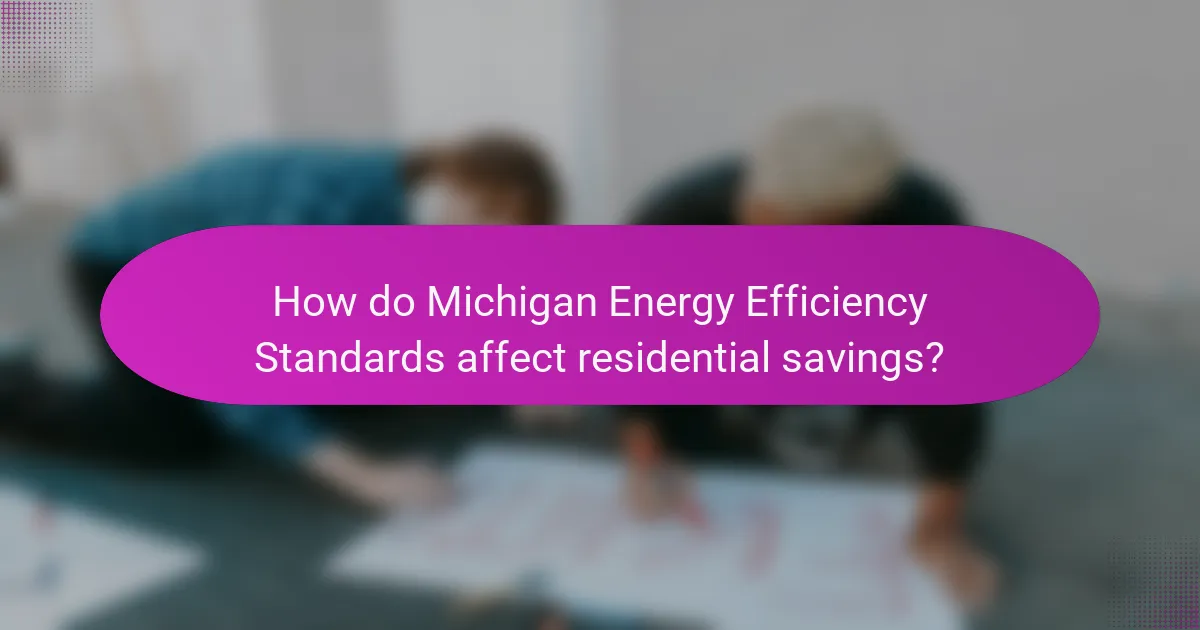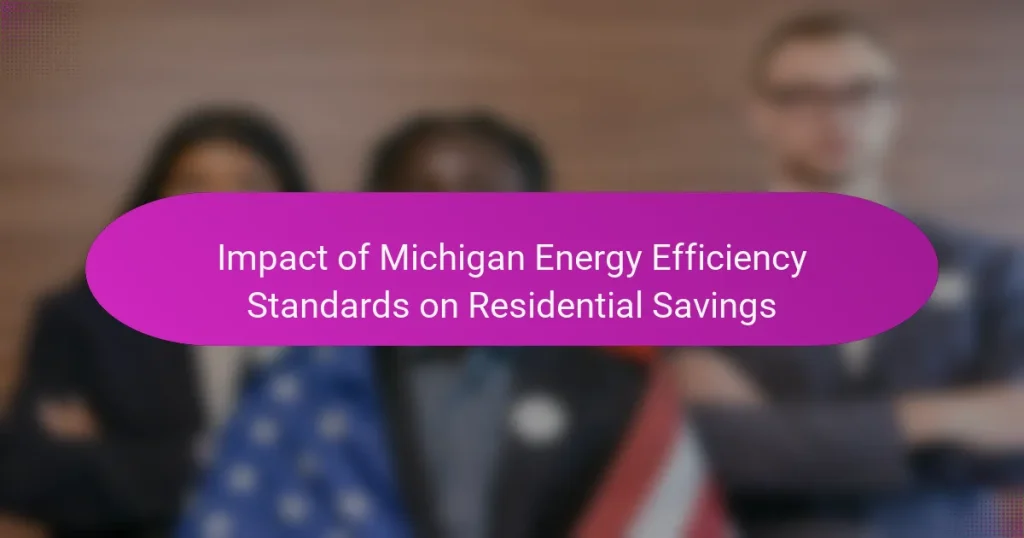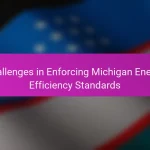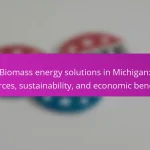
What are Michigan Energy Efficiency Standards?
Michigan Energy Efficiency Standards are regulations aimed at reducing energy consumption in the state. These standards set specific efficiency benchmarks for appliances, equipment, and buildings. They promote the use of energy-saving technologies. The standards apply to various sectors, including residential, commercial, and industrial. Compliance with these standards helps lower energy costs for consumers. Additionally, they contribute to environmental sustainability by reducing greenhouse gas emissions. The Michigan Public Service Commission oversees the implementation of these standards. Studies have shown that adherence leads to significant energy savings for residents.
How were the Michigan Energy Efficiency Standards developed?
The Michigan Energy Efficiency Standards were developed through a collaborative process involving various stakeholders. These stakeholders included state agencies, utility companies, and consumer advocacy groups. The process aimed to establish clear guidelines for energy efficiency improvements in residential and commercial sectors.
The standards were influenced by national energy efficiency benchmarks and best practices. They were also shaped by the need to reduce energy consumption and lower utility costs for consumers. Public input was gathered during the development phase to ensure that a wide range of perspectives was considered.
In 2008, the Michigan Public Service Commission initiated a formal rulemaking process to establish these standards. This process resulted in the implementation of specific energy-saving measures and requirements for utilities. The standards have been updated periodically to reflect advancements in technology and changes in energy consumption patterns.
What stakeholders were involved in the creation of these standards?
The stakeholders involved in the creation of Michigan Energy Efficiency Standards include state government agencies, utility companies, and environmental organizations. State government agencies, such as the Michigan Public Service Commission, provide regulatory oversight. Utility companies contribute insights on energy consumption and efficiency measures. Environmental organizations advocate for sustainable practices and influence policy development. Collaboration among these stakeholders ensures comprehensive and effective standards.
What criteria were used to establish these standards?
The criteria used to establish Michigan’s energy efficiency standards include cost-effectiveness, environmental impact, and technological feasibility. Cost-effectiveness ensures that energy savings exceed implementation costs. Environmental impact assesses reductions in greenhouse gas emissions and other pollutants. Technological feasibility evaluates the availability and reliability of energy-efficient technologies. These criteria help ensure that standards are practical and beneficial for consumers and the environment.
Why are Michigan Energy Efficiency Standards important for residents?
Michigan Energy Efficiency Standards are important for residents because they promote lower energy consumption and reduce utility costs. These standards help ensure that homes use energy more efficiently, leading to significant savings on monthly bills. According to the Michigan Public Service Commission, energy efficiency programs have saved residents over $1 billion since their inception. Additionally, these standards contribute to environmental sustainability by reducing greenhouse gas emissions. The implementation of energy-efficient practices can also increase property values and improve comfort levels within homes. Overall, these standards provide both economic and environmental benefits to Michigan residents.
What impact do these standards have on residential energy consumption?
Michigan energy efficiency standards significantly reduce residential energy consumption. These standards mandate higher efficiency for appliances and building materials. As a result, homes utilize less electricity and gas. According to the Michigan Public Service Commission, residential energy savings increased by approximately 1.5 billion kWh annually due to these standards. This reduction translates to lower utility bills for homeowners. Additionally, energy-efficient upgrades contribute to decreased greenhouse gas emissions. The standards also promote the use of renewable energy sources. Overall, these regulations foster sustainable energy practices in Michigan households.
How do these standards contribute to environmental sustainability?
Michigan Energy Efficiency Standards contribute to environmental sustainability by reducing energy consumption and greenhouse gas emissions. These standards promote the use of energy-efficient appliances and building practices. As a result, households consume less electricity and natural gas. This leads to lower demand on power plants, which often rely on fossil fuels. Consequently, there is a decrease in carbon dioxide emissions. According to the Michigan Public Service Commission, energy efficiency programs saved over 1.5 million megawatt-hours in 2020 alone. This significant reduction in energy use helps to protect natural resources and minimize environmental degradation. Overall, these standards support a transition to a more sustainable energy future.

How do Michigan Energy Efficiency Standards affect residential savings?
Michigan Energy Efficiency Standards significantly enhance residential savings. These standards mandate energy-efficient practices and technologies in homes. As a result, households can reduce their energy consumption. Lower energy usage directly translates to decreased utility bills. For instance, the Michigan Public Service Commission reported that energy efficiency programs saved consumers over $1 billion from 2013 to 2019. Additionally, homes that comply with these standards often experience improved comfort and reduced maintenance costs. Overall, these regulations create a financial incentive for homeowners to adopt energy-saving measures.
What types of savings can residents expect from these standards?
Residents can expect savings in energy costs, maintenance expenses, and water usage from these standards. Energy efficiency standards reduce electricity and gas consumption. This leads to lower monthly utility bills. For example, households may save an average of $200 annually on energy costs. Maintenance savings arise from improved appliance performance and durability. Efficient appliances often require fewer repairs. Additionally, residents may experience savings on water bills due to water-efficient fixtures. These standards promote sustainable practices, ultimately benefiting household finances.
How do energy-efficient appliances contribute to cost savings?
Energy-efficient appliances contribute to cost savings by reducing energy consumption. These appliances use advanced technology to operate more efficiently than standard models. For example, Energy Star-rated appliances consume 10-50% less energy. Lower energy usage results in decreased utility bills. According to the U.S. Department of Energy, households can save $500 annually by using energy-efficient appliances. Additionally, many states offer rebates for purchasing these appliances, further enhancing savings. Over time, the initial investment in energy-efficient appliances pays off through these reduced costs.
What role does insulation play in reducing energy bills?
Insulation significantly reduces energy bills by minimizing heat transfer in homes. It acts as a barrier that keeps warm air inside during winter and prevents heat from entering during summer. This efficiency leads to less reliance on heating and cooling systems. Consequently, homeowners spend less on energy consumption. According to the U.S. Department of Energy, proper insulation can save homeowners 15% on heating and cooling costs. This cost reduction is particularly relevant in regions with extreme temperatures, such as Michigan.
How do these standards influence energy provider pricing?
Energy efficiency standards directly impact energy provider pricing by establishing regulatory benchmarks. These benchmarks require providers to invest in energy-saving technologies and practices. Consequently, providers may pass these costs onto consumers through pricing adjustments. Studies indicate that compliance with efficiency standards can lead to a 10-20% increase in operational costs for energy providers. However, improved efficiency can also reduce overall energy demand. This reduction may stabilize or lower prices in the long term. Therefore, while initial pricing may rise, sustainable savings can occur for consumers over time.
What changes in pricing models have occurred due to these standards?
Pricing models have shifted to reflect the cost savings associated with energy-efficient appliances. Utilities now offer rebates and incentives to encourage the purchase of compliant products. This has led to a decrease in upfront costs for consumers. Furthermore, long-term savings on energy bills are now factored into the pricing strategies. Many manufacturers have adjusted their pricing to remain competitive in a market focused on efficiency. These changes align with the overall goal of reducing energy consumption as mandated by the standards. Energy-efficient products often come with warranties that enhance their value proposition. The result is a more transparent pricing model that emphasizes both initial and ongoing savings.
How do energy savings translate into lower utility bills for residents?
Energy savings directly lead to lower utility bills for residents by reducing the amount of energy consumed. When residents implement energy-efficient practices or appliances, they use less electricity and gas. This reduced consumption reflects in their monthly utility statements. For example, the U.S. Department of Energy states that energy-efficient appliances can reduce energy use by 10-50%. Consequently, lower energy use results in decreased costs on utility bills. In Michigan, energy efficiency standards promote these savings, allowing residents to benefit financially. Studies indicate that households can save an average of $200 annually through energy efficiency improvements.

What are the specific benefits of Michigan Energy Efficiency Standards for homeowners?
Michigan Energy Efficiency Standards provide several benefits for homeowners. These standards promote reduced energy consumption, leading to lower utility bills. Homeowners can save an average of 20% on energy costs annually. Improved energy efficiency enhances home comfort by maintaining consistent indoor temperatures. The standards also contribute to increased property values, as energy-efficient homes are more attractive to buyers. Additionally, homeowners may qualify for rebates and incentives for implementing energy-efficient upgrades. These programs can offset initial investment costs. Overall, Michigan Energy Efficiency Standards significantly support both financial savings and environmental sustainability for homeowners.
How do these standards enhance home value?
Michigan Energy Efficiency Standards enhance home value by improving energy performance and reducing utility costs. Homes that meet these standards typically have lower energy bills, which is attractive to potential buyers. Energy-efficient features can lead to higher appraisals and increased resale prices. According to a study by the National Association of Realtors, energy-efficient homes can sell for 3-5% more than comparable homes without such features. Furthermore, homes compliant with these standards often require less maintenance, adding to their appeal. Overall, these standards create a market advantage for homeowners, resulting in a tangible increase in property value.
What improvements can homeowners make to comply with these standards?
Homeowners can improve energy efficiency by upgrading insulation and sealing air leaks. Proper insulation reduces heat loss in winter and keeps homes cooler in summer. Sealing air leaks around windows and doors minimizes drafts, enhancing comfort and reducing energy costs. Installing energy-efficient windows can also significantly lower heating and cooling demands. Additionally, upgrading to ENERGY STAR-rated appliances decreases energy consumption. Implementing smart thermostats allows for better temperature control and energy savings. Regular maintenance of heating and cooling systems ensures optimal performance and efficiency. These improvements align with Michigan Energy Efficiency Standards, promoting residential savings.
How does compliance with these standards affect resale value?
Compliance with Michigan Energy Efficiency Standards positively affects resale value. Homes meeting these standards typically attract higher offers. Energy-efficient features reduce utility costs, making properties more appealing. Buyers often prioritize lower operating expenses. A study by the Appraisal Institute found energy-efficient homes can sell for 3-5% more. This increase reflects the growing demand for sustainable living options. Compliance signals quality and reduced environmental impact. Thus, adherence to these standards enhances marketability and resale potential.
What challenges do homeowners face in implementing these standards?
Homeowners face several challenges in implementing Michigan’s energy efficiency standards. One significant challenge is the upfront cost of upgrades. Many energy-efficient improvements require substantial initial investment. Homeowners may struggle to finance these upgrades, especially if they are not aware of available incentives.
Another challenge is the complexity of the standards. Understanding the specific requirements can be overwhelming. Homeowners often lack the technical knowledge to navigate energy efficiency regulations. This can lead to improper installations or non-compliance.
Additionally, finding qualified contractors can be difficult. Not all contractors are familiar with the latest energy efficiency standards. Homeowners may have to invest time in researching and vetting professionals who can meet these criteria.
Furthermore, there may be resistance to change. Some homeowners are hesitant to alter their existing systems or habits. This reluctance can stem from a lack of awareness of the long-term benefits of energy efficiency.
Lastly, ongoing maintenance and monitoring of energy-efficient systems can pose challenges. Homeowners must commit to regular upkeep to ensure systems operate efficiently. Neglecting this maintenance can diminish the expected energy savings.
What common barriers prevent residents from achieving energy efficiency?
Common barriers that prevent residents from achieving energy efficiency include high upfront costs, lack of knowledge, and insufficient incentives. High upfront costs deter many residents from investing in energy-efficient upgrades. Many homeowners are unaware of the benefits of energy efficiency or the available resources. Additionally, insufficient incentives from local governments or utility companies limit motivation to pursue energy-saving measures. Research indicates that these barriers collectively hinder the adoption of energy-efficient practices among residents.
How can residents overcome these challenges effectively?
Residents can overcome challenges related to Michigan’s energy efficiency standards by implementing energy-saving practices. They can upgrade to energy-efficient appliances that comply with the standards. Utilizing programmable thermostats can help manage heating and cooling efficiently. Participating in local energy efficiency programs can provide financial incentives for improvements. Additionally, residents can conduct energy audits to identify areas for enhancement. These audits often reveal insulation or air leakage issues that need addressing. Research indicates that homes adopting these measures can see savings of 10-30% on energy bills. By proactively engaging with available resources, residents can effectively navigate the challenges posed by energy efficiency standards.
What practical steps can residents take to maximize savings from these standards?
Residents can maximize savings from Michigan Energy Efficiency Standards by implementing energy-efficient practices. First, they should replace incandescent bulbs with LED lighting. LED bulbs use at least 75% less energy and last 25 times longer. Second, residents should seal gaps and cracks in windows and doors to reduce heating and cooling costs. Proper insulation can save up to 20% on energy bills. Third, using Energy Star-rated appliances can lead to significant savings. These appliances use 10-50% less energy than standard models. Fourth, residents should consider programmable thermostats to optimize heating and cooling schedules. This can save an average of 10-30% on energy usage. Lastly, participating in local energy efficiency programs can provide rebates and incentives for further energy-saving upgrades.
What are the best practices for selecting energy-efficient appliances?
The best practices for selecting energy-efficient appliances include checking for Energy Star certification. Energy Star appliances meet strict energy efficiency guidelines set by the U.S. Environmental Protection Agency. Additionally, compare the energy use of similar models. Look for the EnergyGuide label, which provides estimated annual operating costs. Consider the appliance’s size and capacity, as larger models may consume more energy. Review the appliance’s features and settings that enhance efficiency, such as eco modes. Research the manufacturer’s reputation for reliability and service. Lastly, consider the long-term savings on utility bills, which can offset the initial purchase price.
How can residents conduct an energy audit of their homes?
Residents can conduct an energy audit of their homes by following a systematic process. First, they should list all energy-consuming appliances. This includes heating and cooling systems, water heaters, and major kitchen appliances. Next, they should check for drafts around windows and doors. Sealing these gaps can significantly reduce energy loss. Residents can then examine insulation levels in attics and walls. Proper insulation enhances energy efficiency. Utilizing energy audit software or tools can also help in assessing energy use. Additionally, residents may consider hiring a professional auditor for a comprehensive evaluation. Professional audits often include blower door tests and thermal imaging. These methods provide precise insights into energy efficiency. By implementing findings from the audit, residents can achieve substantial energy savings. According to the U.S. Department of Energy, homeowners can save 5% to 30% on energy bills with effective audits and improvements.
Michigan Energy Efficiency Standards are regulations designed to reduce energy consumption across residential, commercial, and industrial sectors in Michigan. These standards establish efficiency benchmarks for appliances, equipment, and buildings, promoting energy-saving technologies that lead to significant cost savings for consumers and contribute to environmental sustainability. The article explores the development of these standards, the stakeholders involved, and the criteria used to establish them, along with the impact on residential energy consumption and potential savings. Additionally, it addresses challenges homeowners face in implementing these standards and offers practical steps to maximize savings and enhance home value.


